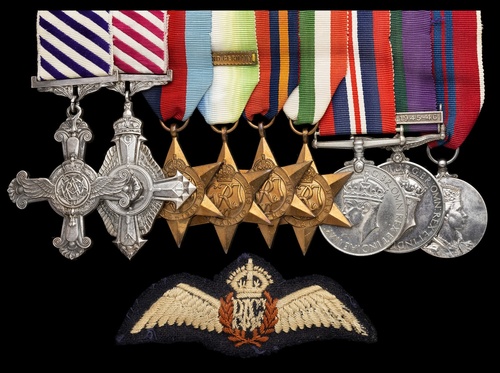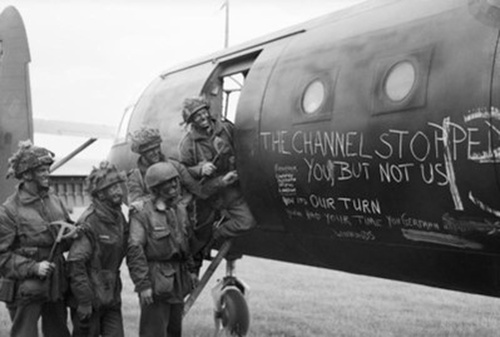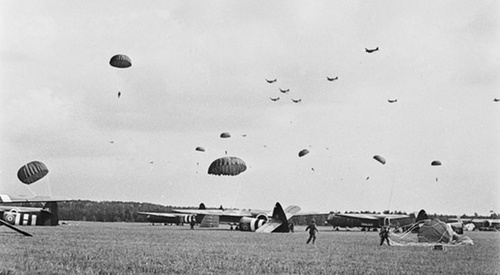Auction: 25001 - Orders, Decorations and Medals
Lot: 385
(x) A fine Second World War Coastal Command D.F.C., D-Day airborne operations A.F.C. group of nine awarded to Wing Commander C. J. Mackenzie, Royal Air Force, late Auxiliary Air Force
Having been credited with the destruction of a U-Boat in the Western Approaches piloting a Hudson of No. 500 (County of Kent) Squadron in April 1942, he transferred to glider towing duties in Dakotas of No. 233 Squadron, in which he participated in Operations 'Tonga' & 'Market Garden'
Distinguished Flying Cross, G.VI.R., the reverse officially dated '1942'; Air Force Cross, G.VI.R., the reverse officially dated '1944'; 1939-45 Star; Atlantic Star, clasp, France and Germany; Burma Star; Italy Star; War Medal 1939-45; General Service 1918-62, 1 clasp, S.E. Asia 1945-46 (Act. Sqn. Ldr. C. J. Mackenzie, R.A.F.); Coronation 1953, mounted as worn, together with embroidered R.A.F. uniform 'Wings', very fine or better (9)
D.F.C. London Gazette 28 July 1942, the original recommendation states:
'Flying Officer Mackenzie has been employed in an operational squadron since the outbreak of war and has completed over 400 hours operational flying in Anson, Blenheim, and Hudson aircraft, mainly on patrols to the enemy coast. He has at all times shown courage, determination, and devotion to duty of the highest order in carrying out any task allotted to him.
On the 28 April 1942, he was captain and pilot of Hudson aircraft K/500 carrying out an A./S. patrol at 4,400 feet in the Western Approaches, when he sighted a U-boat on the surface eight miles away. He made full use of all available cloud cover and sun, and made a dive-bombing attack, pulling out at 60 to 70 feet and releasing four depth charges across the forward part of the still surfaced U-boat. The attack was almost certainly a successful one, the second charge exploding within 10 feet of the hull. The depth-charge attack was followed by a front and rear gun attack, the U-boat then disappearing from sight stern first, leaving a very large patch of frothy brown disturbed water behind.
Flight Lieutenant Mackenzie exploited his sighting to the maximum and made a complete surprise attack. An award to this officer is recommended in the strongest terms, both for general good work since the outbreak of war and for this excellent attack on an enemy undersea raider.'
A.F.C. London Gazette 1 September 1944, the original recommendation states:
'Acting Squadron Leader Mackenzie has displayed exemplary zeal and devotion to duty as a flight commander. His untiring efforts, initiative and exceptional ability have been an inspiration to all with whom he has come into contact, and enabled the flight to reach the high standard of efficiency which led to the carrying out of its airborne operations on D-Day with unqualified success.'
Charles John Mackenzie, born in India on 25 May 1915, was a pre-war member of the Auxiliary Air Force who was called up in August 1939 when he joined No. 500 (County of Kent) Squadron at R.A.F. Detling in the acting rank of Pilot Officer. Initially equipped with Ansons, the squadron converted to Blenheims in April 1941, and thence to Hudsons in November 1941.
In March 1942, the squadron moved to R.A.F. Stornoway for patrols over the Atlantic and the approaches to the Clyde and the Irish Sea. On 28 April, whilst the captain and pilot of a Hudson, Mackenzie convincingly attacked an enemy U-boat in the Western Approaches, approximately 350 miles due west of the Outer Hebrides, an act of skill and gallantry which resulted in the award of his Distinguished Flying Cross.
Operation 'Tonga'
Advanced to Squadron Leader, Mackenzie next transferred to Transport Command and was posted to No. 233 Squadron at R.A.F. Blakehill Farm. And it was from here that he was charged with glider-towing operations for Operation 'Tonga' between 5-7 June 1944, delivering paratroopers and equipment for the 6th Airborne Division. According to the squadron's Operation Record Book (O.R.B.), it was 'given the envious choice of Drop Zone 'K' - the furthest inland.'
Taking off at 23:14 hours on 5 June 1944, the squadron successfully dropped 407 paratroopers complete with kit bags and containers in an area north-west of Toufreville. The O.R.B. noted much light flak being encountered along the French coast and two Dakotas failed to return to base. Mackenzie's aircraft was among those damaged the following night, when he returned to Normandy for Operation 'Rob Roy One'. But the squadron's good work had not been in vain, for on the morning of 7 June it received the following message from Air Chief Marshal Sir Trafford Leigh Mallory:
'Will you please convey my heartiest congratulations to 46 Group on their magnificent performance in carrying over the 6th Airborne Division in the initial operation. The fact that so successful and difficult an operation has been carried out with such complete success in so short a time after the formation of the squadrons reflects highest credit on all concerned.'
For his services as a flight commander in the run-up to the Normandy Landings, and for his work on D-Day itself, Mackenzie was recommended for and received the A.F.C.
Operation 'Market Garden'
The squadron's next mission was Operation 'Market Garden', when in order to facilitate the Second Army's advance through Holland, the 1st Airborne Division was to be landed at several landing zones in the vicinity of Arnhem to secure bridges over the River Rhine. On 17 September, with Mackenzie piloting one of 22 squadron Dakotas, No. 233 successfully released gliders that contained 309 troops, 18 handcarts, 15 motor cycles, 10 Jeeps, 11 trailers, 5 wireless set, 11 cycles, and 1 6-pounder anti-tank gun, without any loss. On the second day they repeated this feat, with 17 aircraft from the squadron towing gliders containing 84 troops, 15 Jeeps, 7 trailers, 8 6-pounder anti-tank guns, and 3 machine-guns, but the re-supply missions were less fortunate, and the squadron lost 5 aircraft over the next three days, losses recalled by the posthumous award of the V.C. to David Lord, another Dakota pilot.
The R.A.F. Memorial Flight's C-47 Dakota is currently painted up to represent a No. 233 Squadron aircraft, as flown by the likes of Charles Mackenzie over Arnhem.
With the war in Europe over, Mackenzie remained in the Royal Air Force, going out to South-East Asia later in the year. He was promoted Wing Commander in July 1954 and, having settled in Eastbourne on his retirement, died in February 1970.
Sold with his original 'Notice of Calling Out', dated 23 August 1939, together with his original commission warrant for the rank of Pilot Officer, dated 17 May 1940, and several photographs.
For his corresponding dress miniatures please see lot: 447.
Subject to 5% tax on Hammer Price in addition to 20% VAT on Buyer’s Premium.
Estimate
£2,000 to £3,000
Starting price
£1600









